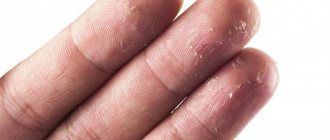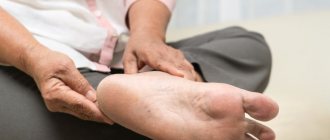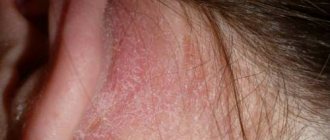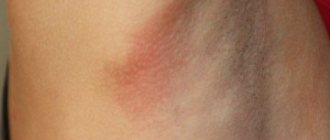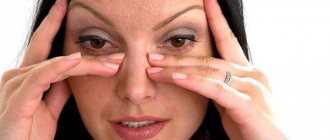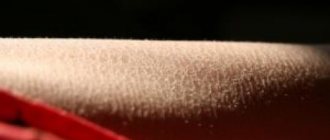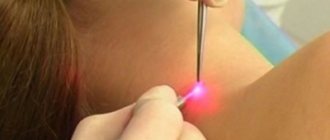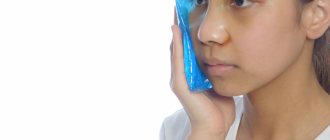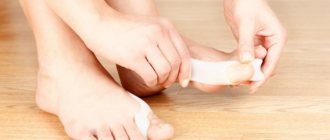Causes
The cause of a symptom such as a rash on a child’s hands depends on various factors. Rashes can be caused by pathogenic microbes, chemicals, mites, or the body’s reactions to allergens.
Allergy
Allergic reaction. The baby may have eaten, touched, or put on something, causing the top layer of skin to react in the form of rashes on the arms, legs, cheeks, or the entire face, neck, butt, abdomen, feet, and chest . Most often, parents do not immediately notice a skin reaction to an allergen, so it is sometimes difficult to determine which object or food is the culprit of the unpleasant symptoms.
The most dangerous thing is prolonged contact with the allergen, the surface of the skin itches, and the number of rashes increases.
Atopic dermatitis
This type of dermatitis is an indicator of the presence of a congenital allergy. In such cases, a rash on the child’s hands appears with frequent contact with a certain allergen. Most often, the allergic rash that appears with this disease is located symmetrically on the skin. It can be found on the legs, face, butt, both hands, elbows, cheeks, stomach, between the legs and on the fingers. The rashes themselves are represented by small blisters.
Blisters of atopic dermatitis may become wet and burst, after which they are covered with a dry crust. It happens that a dry rash itches.
Infections and viruses
Rashes can appear as a result of certain infectious diseases. Basically, the manifestations characteristic of such diseases can be observed primarily on the torso (chest or abdomen), on the hands, wrists and fingers. Parents may notice the rash already at the moment when it spreads to the limbs. However, when infected with the Coxsackie virus, a small red rash will be localized only in the arm area.
Failure to comply with hygiene rules
If a child has a small red rash on his hands , then you should take a closer look at his hygiene after playing outside. After each walk, the child should wash his hands thoroughly. Rashes due to poor hygiene are often accompanied by severe itching.
Parasites
In children's groups, for example, in kindergarten, you can often find a parasite that causes scabies. The disease is spread by the scabies mite, which is transmitted from an infected child through the touch of hands, as well as through objects that he used. With this disease, rashes can be observed between the fingers . The child is bothered by severe itching. With scabies, the rash appears in the form of blisters, small plaques and pimples.
If a parasitic infection of the skin of the hands is detected, the doctor prescribes immediate treatment.
Nervous
Prolonged and severe stress can provoke a rash, which is of a nervous nature. Similar rashes are observed on the legs, face, butt, cheeks, stomach, neck, chest and arms .
These rashes are accompanied by itching at a time when the child is nervous or worried.
Allergy on the back
› Allergy on body
The appearance of a rash on the back is accompanied by discomfort with further itching. There are various factors that provoke the formation of rashes. One of the most common is allergies. A rash on the back needs to be treated with the help of specialists, because it is necessary to establish the true cause of its manifestation.
Causes of allergic rashes
Allergies on the back manifest themselves in the form of rashes of various types. It can be triggered by the following factors:
- pollen of various types of flowering plants;
- use of medications without supervision by a treating specialist;
- use of personal hygiene products or cosmetics of low quality;
- hormonal imbalances in the body;
- use of foods with high levels of allergens in the diet;
- predisposition at the genetic level;
- lack of proper care for the skin of the back in the presence of significant sweating;
- wearing synthetic clothing.
Symptoms of an allergy rash
Rashes on the back may be accompanied by main and associated symptoms. Their manifestations depend on the allergen that provoked the pathology. The main symptoms include:
- formation of peeling of the skin and itching on the back;
- clearly defined dermatitis forms on the back, with redness on the skin;
- in severe forms of the pathology, increased irritability may be recorded, which is due to the negative effect of allergens on the human nervous system;
- There may be an increase in body temperature.
When symptoms initially appear, you should consult a doctor, especially if your back is constantly itching. This will eliminate more significant complications.
Allergic manifestations in the back area in an adult
Associated symptoms include:
- further spread of the rash throughout the patient’s skin, with dry skin and itching;
- red spots, watery or purulent formations, as well as other visually visible forms of rashes appeared on the patient’s back;
- general weakening of the body, fleeting fatigue, loss of appetite, drowsiness and lethargy;
- disturbances in the functioning of the gastrointestinal tract.
Drug therapy
If initial signs of allergic rashes are detected, you should seek help from specialized specialists. They will conduct an examination of the patient, on the basis of which they will direct you to undergo the required tests. In the future, the required course of therapy will be drawn up, which is aimed at suppressing the primary sources of excitation of the rash.
Professionals can take the following steps to combat back allergy rash:
- Prescribe antihistamines. Among the most used are Zodac and Loratadine. They are designed to relieve irritation and itching on the back. Topical preparations in the form of gels and ointments may also be prescribed.
- A specific diet is prepared for the patient, which includes the exclusion of foods containing allergens. As a rule, the consumption of sweets, smoked foods and alcoholic beverages is not allowed.
- The use of medicines based on menthol or camphor.
- In severe forms of pathology, novocaine therapy is prescribed.
Diagnostics
In order to select adequate treatment for a rash on a baby’s hands, the pediatrician needs to diagnose this manifestation of the disease. First of all, the temperature will be measured. After which the patient may be referred to an allergist and dermatologist. Experts will be able to differentiate the disease by appearance. Then additional tests are prescribed.
If an allergic cause of the rash on the hands, which may also be present between the fingers, elbows, legs, face, butt, cheeks, stomach or neck, is not confirmed, the child will be referred to a dermatologist-infectious disease specialist.
First of all, the specialist will ask the parents about the timing of the onset of symptoms of the rash, their probable cause and the measures taken to eliminate the rash. Afterwards the little patient was examined. The doctor performs an examination with a detailed study of the appearance and localization of the rashes, which can be not only on the hands, but also between the toes, face, butt, knees and elbows, cheeks and neck.
Kinds
Various diseases can be accompanied by characteristic types of rash, which vary in size, color, shape and nature of its surface. also differ from each other by the presence of contents, for example, fluid or pus . Common types of rash:
- Vesicle , represented by vesicles, is usually filled with liquid and reaches 0.5 cm in diameter. Most often, when it is damaged, a wet patch of skin appears.
- The macula , which looks like a speck, is the part of the skin where color changes have occurred. However, this rash does not rise above the surface of the skin. It can appear not only on the hands, but also on the face, butt, and other areas of the skin.
- The bubble (not to be confused with a bubble) is 0.5 - 2 cm in diameter.
- The blisters are spherical, irregular in shape and look like bubbles. The size of the blisters exceeds 0.5 cm.
- A pustule is an abscess that protrudes above the surface of the skin and is filled with pus.
- A white rash on the hands may indicate the presence of allergic dermatitis. The white rash is initially small in size and occupies small areas of the skin, then begins to spread throughout the body.
Treatment
After diagnosing the rash, the specialist should prescribe treatment. Parents should not treat rashes on the arms, butt, abdomen and other areas of the skin of a small child on their own, especially if the child has a fever.
Treatment of rashes is divided into two main areas:
- relieving symptoms such as fever and rashes and unpleasant itching;
- treatment of the disease that led to the rash.
Treatment may be required with antihistamines , local agents, which are represented by ointments, creams, gels containing hormones . The rash sometimes has to be treated with injections of drugs or medications taken orally.
- Read in more detail: what different rashes look like
Treatment may involve taking antifungal, antiviral, or antibacterial agents . But don’t forget about taking vitamins that will help strengthen the child’s immune system. And itching can be treated with sedatives and antiallergic cooling gels.
Sometimes the doctor suggests treating a rash on the hands with special ultraviolet lamps, which can be included in physiotherapy. The rays of such devices can destroy bacteria and eliminate acne.
What disease do red palms indicate?
Red palms of the hands are an indicator of a person’s health status and in most cases change their natural flesh color to brighter tones due to an allergic reaction of the skin to one or another external irritant that a person encounters every day due to certain circumstances.
If the allergy is not diagnosed and there are no accompanying signs of skin irritation in the form of itching, rash and swelling of the epidermal tissues, then it is possible that red palms of the hands signal a disease of the internal organs.
Let us consider in more detail in what pathological cases the color of the skin of the palms of the hands suddenly changes, as well as what diseases this may be associated with.
Causes - what kind of disease could this be with red palms?
allergies on the palms in the photo
Sometimes the skin on the palms becomes filled with excess blood and turns red in hot weather, when the high temperature causes the blood pressure in the blood vessels to rise slightly above the optimal level. This is a normal reaction of the body and there is no need to sound the alarm about the changed shade of the skin of the palms.
It is much worse if this condition of a part of the upper limbs acquires unhealthy constancy, regardless of the temperature of the environment. In this case, one or another disease of the internal organs can be suspected.
People with chronic redness of the epithelial surface of the palms may have the following diseases and pathological conditions of the body:
Allergy
Daily contact with a potential irritant over time forms a stable autoimmune reaction of the body, which is expressed in redness of the palms. This is the primary stage of development of an allergic reaction. It is caused by systematic exposure of the skin of the palms to chemical, medical or cosmetic preparations.
To eliminate the allergen, you need to reconsider your lifestyle and remove all possible factors that influence the occurrence of this type of allergy.
If the patient does not take any adequate response measures, then redness is subsequently accompanied by symptoms such as itching, the formation of a rash in the area of the hand and wrist, peeling of the affected skin and swelling of the tissues.
Liver diseases
In case of damage to liver tissue as a result of an increased burden of processing toxins, or due to an infectious invasion that provokes inflammation, the skin is the first to signal problems with the health of this part of the digestive system.
Most often, a red tint to the epithelial surface of the palms appears if the patient is diagnosed with liver diseases such as cirrhosis, hepatosis, and hepatitis.
All of them are successfully treated with medications, but only in the initial stages of the development of the disease.
Avitaminosis
Chronic deficiency of B vitamins, which are directly involved in the formation of the skin, leads to the fact that the palms begin to turn red, the hands become numb and itchy.
Over time, the process of keratinization of the epidermis develops and dead cells peel off.
In addition to changes in skin tone, a person with vitamin B vitamin deficiency experiences increased fatigue, irritation, and deterioration in the health of nails and hair.
Lane's disease
A genetic disease, inherited, which is characterized by erythema of the skin of the palms with their redness. The main reason for the development of the disease is a violation of the venous circulation of the upper extremities, when the smallest vessels, the capillaries located in the palms, do not fully receive blood supply.
As a result of this pathological process, their cellular structure changes and they acquire a purple-blue hue. Because of this, the skin of the palms looks like one solid red spot of rich color. Lane's disease can manifest itself at any age.
It is diagnosed both in newborns and in people who are already at a fairly mature age.
These are the main reasons that influence the change in color of the skin of the palms from natural flesh to red shades.
It is possible that if you seek medical help and undergo a diagnostic examination of the body, other factors may be identified that influence the negative reaction of the skin of the hands.
Treatment - how to get rid of allergies on the palms?
The process of treating an allergic reaction that manifests itself on the palms of the hands consists of the use of traditional medications that belong to the antihistamine group. In the treatment process, the following means are used:
- Tablets Aleron, Ketotifen, Eden, L-cet. Take them orally with the required amount of water. The dosage of each type of drug is different. Some medications need to be taken 2-3 tablets daily, but an allergy medicine such as Aleron is enough to take only 1 tablet per day, but at the same time. The final dosage and timing of therapy is determined by an allergist or therapist if a specialized specialist is not available at the medical institution.
- Suprastin, Suprastinol, Diprospan, Prednisolone, Ruzam. These are intramuscular injections of antihistamines. Intended for the treatment of acute forms of an allergic reaction. Injection therapy by intramuscular administration of the drug is used if taking tablet forms of antiallergic drugs does not bring a positive effect.
- Ointments and creams Epidel, Lanolin, Dropalen, Fluorocort. They are applied directly to the surface of reddened palms. The active components of antihistamine drugs in this category reduce swelling of the epidermal tissues, relieve itching, and prevent the formation of rashes. The use of ointments and creams in the treatment of reddened palms is effective only in complex therapy.
To achieve the most positive result aimed at getting rid of redness of the skin of the palms, it is imperative to identify the allergen that provokes the pathological condition of the epithelium and eliminate it from your usual lifestyle. Only then can you count on a complete cure for allergies.
Traditional treatment for red palms
Alternative medicine has its own recipes that help remove sudden and chronic redness of the skin of the hands. The following traditional methods are used for this:
Baths from a series
It is believed that this medicinal plant has unique therapeutic properties when the patient has various dermatological diseases.
Among the people, baths made from a decoction of the string are perceived as a universal remedy for any dermatitis and allergic manifestations on the skin.
To treat with this method, you need to pour 2 liters of boiling water over 30 grams of dried string and close the container in which the medicinal plant is located for infusion.
After the specified time, the broth is poured into a basin. After this, the person steams his hands in a decoction of the string for 20-30 minutes. This procedure must be performed daily in the evening. The duration of treatment is 10 days. During this period, the redness of the palms should completely disappear.
Aloe and honey compresses
To prepare this folk medicine, you will need to take 1 leaf of an aloe flower, wash it thoroughly under running water and twist it through a meat grinder, or grind it in any other convenient mechanical way. The end result should be a paste. The juice should be squeezed out to form a dense green mass. 1 teaspoon of honey is added to it and the gruel is mixed until smooth.
The principle of treatment is that crushed aloe with honey is laid out on a gauze cloth, and then attached to the surface of the red palms in the form of a compress.
Medicinal aloe flower in combination with honey has a sustainable anti-inflammatory effect, improves local blood circulation, and relieves swelling.
The positive therapeutic result becomes an order of magnitude higher if, in parallel, therapy is carried out for the main cause that provoked the redness of the palms.
Treatment with bile
If the redness of the skin of the palms is caused by liver disease, then folk therapy for this disease is based on the fact that the patient must swallow the gall bladder of a young rooster. This organ of the poultry digestive system is consumed orally in its raw form.
In addition, it has a pronounced bitter taste, so it is not recommended to bite into it. It is best to drink it with a glass of cold water. It is believed that after just one procedure, the functioning of the liver tissue will stabilize, and the redness of the palms will completely disappear.
Traditional medicine is very skeptical about these methods of traditional treatment, since their implementation does not require diagnosis and examination of the body. Dermatologists and allergists recommend that patients do not self-treat red palms at home, but seek help only from medical institutions.
Prevention of red palms
In order for the skin of the palms to maintain its usual and healthy flesh color, it is necessary to observe daily preventive measures, which include the following:
- a balanced diet that contains only biologically healthy products containing sufficient amounts of vitamins, minerals, amino acids, proteins and complex carbohydrates (chicken meat, ocean fish, eggs, fresh vegetables and fruits, cereals, herbs, dairy products);
- refusal to drink alcohol, smoke tobacco and other harmful habits, the presence of which systematically reduces the protective function of the immune system and negatively affects skin health;
- use of protective gloves when working with chemicals and cosmetics;
- regular preventive medical examinations by a dermatologist.
Following these simple rules will help preserve the natural color of the skin of the palms and prevent allergic redness or changes in the color of the epithelium under the influence of other factors.
Source: https://furunkul.com/allergiya/krasnyie-ladoni-ruk-priznak-kakoy-bolezni.html
